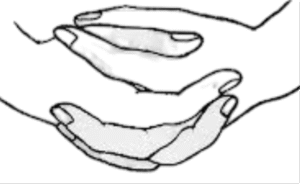Venus Lock Mudra
Introduction
Venus Lock Mudra is a hand gesture in yoga and meditation that is believed to enhance creativity, emotional balance, and heart-centered energy. It is inspired by the qualities associated with Venus—the planet of love, harmony, and beauty—and is used to promote inner peace, emotional stability, and relational harmony.
This mudra is often practiced in meditation, pranayama, and energy work to open the heart chakra (Anahata), stimulate emotional intelligence, and cultivate a sense of calm and connectedness.
Meaning
Venus: Planet symbolizing love, beauty, creativity, and harmony.
Lock: Represents the sealing or focusing of energy.
Mudra: Hand gesture used to influence pranic energy and emotional balance.
Overall Meaning:
Venus Lock Mudra locks and channels energy to the heart and emotional centers, fostering creativity, emotional resilience, and relational harmony.
How to Perform / Practice
Sit comfortably in a meditative posture (Padmasana, Sukhasana, or on a chair) with a straight spine.
This pose is done by interlocking the fingers. For women, the right pinky is at the bottom, while for men it is at the left. One of the thumbs touches the fleshy part between the thumb and index finger.
Close your eyes, breathe slowly and deeply, and focus on love, creativity, and heart-centered energy.
Practice for 10–20 minutes daily, gradually increasing with experience.
Tip: Best practiced during meditation, creative work, or emotional regulation exercises.
Benefits
Physical Benefits:
Relieves tension in the hands, wrists, and shoulders.
Supports postural stability during seated meditation.
Improves circulation in the arms and hands.
Mental & Emotional Benefits:
Enhances emotional intelligence and inner harmony.
Reduces stress, anxiety, and emotional imbalance.
Fosters creativity, relational harmony, and self-expression.
Energetic / Spiritual Benefits:
Opens and balances the heart chakra (Anahata).
Promotes smooth flow of pranic energy in emotional and relational centers.
Encourages a sense of love, compassion, and connectedness.
Contraindications
Avoid if experiencing hand, wrist, or finger injuries.
Not recommended for severe arthritis or joint pain.
Discontinue if numbness, tingling, or discomfort occurs.
Practice moderately if experiencing emotional hypersensitivity, to avoid overstimulation.
Anatomy & Physiology
Muscles: Engages intrinsic hand muscles (lumbricals, interossei) and forearm muscles for finger interlocking.
Joints: Flexion at interlocked fingers; relaxed wrist and shoulder positioning.
Nervous System: Activates parasympathetic pathways, promoting calmness and emotional regulation.
Circulation: Enhances blood flow in hands and arms, indirectly supporting energetic and emotional balance.
Kinesiology
Improves fine motor coordination through interlocking fingers.
Enhances static postural stability while seated.
Encourages a relaxed and stable hand posture, supporting meditation and emotional focus.
Neurology
Stimulates brain regions associated with emotional regulation, empathy, and creativity.
Balances sympathetic and parasympathetic activity, reducing stress and anxiety.
Supports neural pathways related to attention, relational awareness, and heart-centered focus.
Duration of Practice
Daily Practice: 10–20 minutes, ideally during meditation.
Short Practice: 5 minutes for emotional centering or creativity boost.
Can be combined with Anahata-focused meditation or Prana Mudra for enhanced energetic benefits.
Counter Mudra
If excessive tension or stiffness occurs, switch to Gyan Mudra or Chin Mudra.
Gentle hand shaking or stretching is recommended after long practice.
Conclusion
Venus Lock Mudra is a gesture for emotional balance, heart-centered energy, and creativity. Regular practice cultivates love, harmony, emotional intelligence, and inner peace, making it ideal for meditation, creative work, and relational well-being.
FAQ
Q1: Can beginners practice Venus Lock Mudra?
A: Yes, it is simple and safe; start with a few minutes and gradually increase.
Q2: Can it improve emotional and relational harmony?
A: Yes, it enhances emotional intelligence, empathy, and calmness.
Q3: Can it be combined with other mudras?
A: Yes, it can be combined with Prana Mudra or Dhyana Mudra for enhanced energetic and emotional benefits.
Q4: Is it suitable during meditation?
A: Yes, it promotes calmness, creativity, and heart-centered awareness.
References
Swami Satyananda Saraswati, Mudras for Healing and Transformation.
Iyengar, B.K.S., Light on Yoga.
Saraswati, S., Pranayama and Mudras in Yoga Therapy.
Fishman, L., Yoga for Emotional Balance.
Lad, V., Ayurveda: The Science of Self-Healing.
Journal of Bodywork and Movement Therapies, 2018; 22(4): Effects of Hand Mudras on Mental and Physiological Functions.

